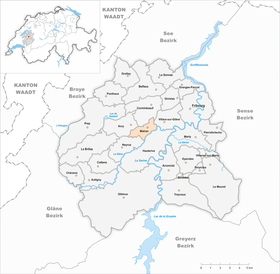Matran
| Matran | |
|---|---|
| State : |
|
| Canton : |
|
| District : | Saane |
| BFS no. : | 2208 |
| Postal code : | 1753 |
| UN / LOCODE : | CH MAT |
| Coordinates : | 573.76 thousand / 181656 |
| Height : | 614 m above sea level M. |
| Height range : | 570–683 m above sea level M. |
| Area : | 2.91 km² |
| Residents: | 1521 (December 31, 2018) |
| Population density : | 523 inhabitants per km² |
| Website: | www.matran.ch |
|
Matran |
|
| Location of the municipality | |
Matran ( Freiburger Patois ) is a municipality in the District de la Sarine (German: Saanebezirk) in the canton of Friborg in Switzerland .
geography
Matran is 614 m above sea level. M. , 5.5 km west-southwest of the canton capital Friborg (linear distance). The village extends on the northern slope of the lower Glânetal , shortly before its confluence with the Saane , in the molasse heights of the Freiburg Central Plateau .
The area of the municipal area of 2.9 km² covers a section of the Molasse Heights between the valleys of Sonnaz and Glâne. The southern border runs along the Glâne, which emerges from a narrow valley cut deep into the high plateau and forms a wide basin. The Bagne side stream flows into this widening of the valley from the west . The municipality extends from the Glâne northward over the valley floor and the slope of Matran to the adjacent Molasse heights (in the Bois Murat 670 m above sea level ). To the west, the municipal spell extends in the Bois des Morts and along the valley of the Bagne to the Bois de Chavagny forest , at 685 m above sea level. M. the highest point of Matran is reached. In 1997, 30% of the municipal area was in settlements, 17% in forests and woodland, 52% in agriculture and a little less than 1% was unproductive land.
Extensive new residential and commercial areas belong to Matran. The neighboring municipalities of Matran are Corminboeuf , Villars-sur-Glâne , Hauterive , Neyruz and Avry .
population
With 1521 inhabitants (as of December 31, 2018), Matran is one of the medium-sized communities in the canton of Friborg. 87.5% of the residents are French-speaking, 7.5% German-speaking and 1.4% speak Italian (as of 2000). The population of Matran was 309 in 1900. In the course of the 20th century, the population rose slightly to 454 people by 1970. Since then, there has been a marked increase in population combined with almost tripling the number of inhabitants within 30 years.
economy
Until the second half of the 20th century, Matran was a predominantly agricultural village. Since the 1970s there has been a rapid development into the agglomeration community of Freiburg with large commercial areas. Between 1950 and 1995, the Saint Joseph College of the Redemptorists with around 200 students also brought about an economic boom.
Agriculture with dairy farming , cattle breeding and arable farming has only a marginal role in the income structure of the population today. Thanks to the excellent transport links, various larger companies and shops have set up shop in Matran. In the community there are companies in the building and transport industry, metal construction, information technology, the beverage industry and timber construction. In the last few decades the village has also developed into a residential community. The new residential areas are located on the slope east of the old town center and west of the A12 motorway. Numerous workers are therefore commuters who work mainly in the Freiburg agglomeration.
traffic
The community is very well developed in terms of transport. It is located a little above the main road from Freiburg to Romont . The next connection to the A12 motorway (Bern-Vevey), which opened in 1977 and crosses the municipality, is around 1 km from the town center. On September 4, 1862, the railway line from Lausanne to Freiburg with a train station at Matran was put into operation. A bus line from Transports publics Fribourgeois , which runs on the route from Freiburg to Rosé , provides for the fine distribution of public transport .
history
The first written mention of the place took place in 1138 under the name Martrens en Nuithonie . The names Martrans (1148), Matrans (1157), Martranz (1285), Martrant (1445), Martrand (1555) and Matrang (1668) appeared later . The place name goes back to Martyrus .
In the Middle Ages , Payerne Abbey owned rich estates in Matran. The village came under the rule of Freiburg through purchase in 1442 and was assigned to the old landscape (Neustadtpanner). After the collapse of the Ancien Régime (1798), Matran belonged to the Friborg district during the Helvetic and the following period, before it was incorporated into the Saane district in 1848 with the new cantonal constitution.
Sons and daughters of the church
- Magali Pache (1978-2000), racing cyclist
Attractions
The Catholic Church of St. Julien was first mentioned in a bull by Eugene in 1146. In 1651 the church was partially destroyed by a fire. The paintings by Gottfried Locher were rediscovered in 1974 when the false ceiling was demolished and then restored.
Web links
- Official website of the municipality of Matran (French)
- Marianne Rolle: Matran. In: Historical Lexicon of Switzerland .
Individual evidence
- ↑ Permanent and non-permanent resident population by year, canton, district, municipality, population type and gender (permanent resident population). In: bfs. admin.ch . Federal Statistical Office (FSO), August 31, 2019, accessed on December 22, 2019 .
- ↑ Source: Information sheet from the restorer Thérèse Mauris








